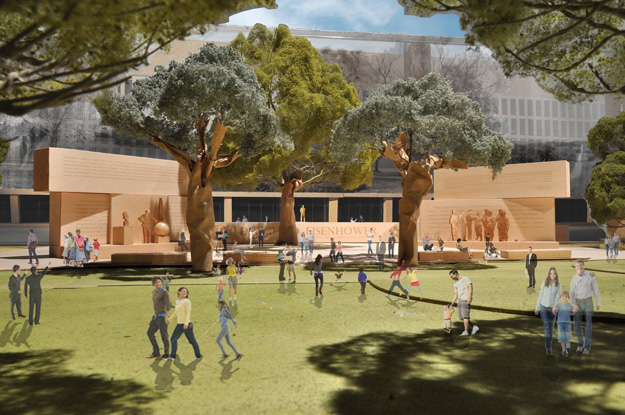 |
| Image courtesy EMC |
|
Gehry has made several changes to the original design: A statue of Eisenhower as a seated barefoot boy has been moved from the center to the back and will now show him as a standing young man; Two free-standing sculptures, rather than bas reliefs in stone walls, will depict Eisenhower as a general and president; The walls will contain quotes from Eisenhower speeches. |
On Tuesday morning, the 11-member Eisenhower Memorial Commission (EMC) met in a Senate office building to review changes made by Gehry Partners for its design of a President Dwight Eisenhower memorial in Washington, D.C. The proposed scheme has drawn fire from Eisenhower family members and fans of architectural classicism. The most prominent complaint is that it diminishes Eisenhower by emphasizing his humble roots rather than his professional achievements.
Although the Eisenhower family has not taken up Frank Gehry’s offer to meet and discuss their concerns, his firm has made several changes to the design in response to some of their public criticisms. Most significantly, a life-sized statue that would have presented Eisenhower as a seated barefoot boy in Kansas has been moved from the center to the back of the memorial, and it will now show him as a standing young man. “Disparate voices have helped us fully understand [Eisenhower’s] character,” said Meaghan Lloyd, a colleague of Gehry, who read a letter he wrote to the EMC and spoke on his behalf.
Another major change: Two free-standing sculptures, rather than bas reliefs in limestone walls, will depict Eisenhower as a general and president. One sculpture will show Eisenhower meeting with soldiers from the 101st Airborne division before their arrival in Normandy; the other will show a distinguished Eisenhower with his hand on a globe (an image derived from a 1966 photo titled “The Elder Statesman”). The limestone walls will feature quotes from Eisenhower’s speeches, although the specific quotes are yet to be determined.
Of the roughly half dozen commission members who spoke, all expressed support for the changes and the design in general. Alfred Geduldig, a commissioner from New York, called it “the realization of what we’ve been dreaming” since the EMC was formed in 1999. Sanford Bishop, a Congressman from Georgia (eight of the EMC members serve in Congress), said he “appreciates Gehry being flexible,” adding, “we have arrived at almost a consensus to go forward.” William Thornberry, a Congressman from Texas, added: “Over time it’s gotten better. We’re grateful for Gehry and his team’s willingness to listen and adjust.”
The memorial is to be constructed on an empty lot between the Department of Education and the National Air and Space Museum, just south of the National Mall. It’s unclear when the EMC will vote on the updated design. On July 12, the design will be presented to the National Capital Planning Commission for its approval.
The Eisenhower family was conspicuously absent from today’s hearing. Representatives from the National Civic Art Society, another critic of the design, were present—and they remain unimpressed. “It’s rearranging deck chairs on the Titanic,” said Justin Shubow, the group’s chairman. Shubow says the metal tapestry ringing the site will be too large and the sculpture now depicting Eisenhower as a young man is too small. Also, the addition of off-center lintels on the limestone blocks disturbs Shubow. “That represents disorder and danger,” said Shubow. “That’s Gehry.”

Post a comment to this article
Report Abusive Comment